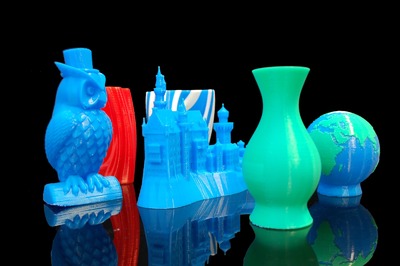 Bits From Bytes has suddenly released AXON 3, a new version of the software they use to slice models for their line of personal 3D printers, including the RapMan, BFB 3000 and 3D Touch.
Bits From Bytes has suddenly released AXON 3, a new version of the software they use to slice models for their line of personal 3D printers, including the RapMan, BFB 3000 and 3D Touch. The new version has two incredible new features: multi-material capability and one more we’ll save for a moment.
 The multi-material feature lets you load in up to three 3D models (one per extruder on your machine) for printing. The (up to) three models are interleaved during printing to produce a multi-material object – assuming you’ve loaded different materials into each extruder, of course! We’d recommend using different colors of the same plastic type to produce amazing output.
The multi-material feature lets you load in up to three 3D models (one per extruder on your machine) for printing. The (up to) three models are interleaved during printing to produce a multi-material object – assuming you’ve loaded different materials into each extruder, of course! We’d recommend using different colors of the same plastic type to produce amazing output. While colorful models are terrific, the second feature is one we like a lot more: speed. We benchmarked the difference between AXON 2.1 and AXON 3 on a large 1400 layer model and found the new software is a bajillion times faster! Well, maybe it just seemed that must faster; in reality the process took 28 long minutes on AXON 2, while AXON 3 completed the task in less than 50 seconds (including ten seconds of post-build analysis). AXON 3 seems to be around 34 times faster than its predecessor!
We suspect that BFB has moved away from the overly complicated and ponderously slow Skeinforge open source slicing engine. Their move mirrors similar tacts by MakerBot and other manufacturers who have been replacing Skeinforge with faster alternatives. In other words, if you’re still slicing with Skeinforge, you’re probably doing it wrong.
Is there anything wrong with AXON 3? Yes, there are two things amiss: first, it’s currently available only for the 3D Touch; BFB says they’ll be updating the firmware to permit its use on the 3000 and RapMan soon.
The second problem with AXON is that it still runs only on Microsoft Windows platforms. While this constraint could have been explained away years ago, Windows is not nearly as dominant today as it has historically been. OS/X and Linux have become much more prominent and should now be supported by BFB, as is done by MakerBot and other BFB competitors. Evidence: non-mobile Fabbaloo readers are now 26% OSX and 8% Linux, while Windows readers are 68% and dropping.
Via Bits From Bytes

